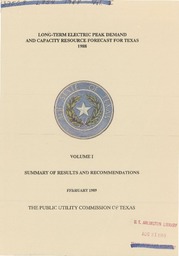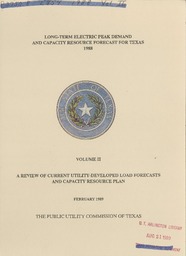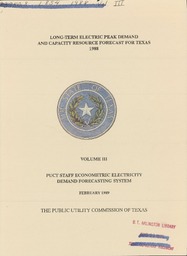
ATTENTION: The works hosted here are being migrated to a new repository that will consolidate resources, improve discoverability, and better show UTA's research impact on the global community. We will update authors as the migration progresses. Please see MavMatrix for more information.
Show simple item record
| dc.contributor | Texas. Public Utility Commission. | |
| dc.date.accessioned | 2017-04-07T16:55:29Z | |
| dc.date.available | 2017-04-07T16:55:29Z | |
| dc.identifier.uri | http://hdl.handle.net/10106/26544 | |
| dc.description | "February 1989." | |
| dc.description.abstract | Although electric utilities in Texas have entered a period of significant excess generating
capacity, a number of planning issues deserve prompt attention. These issues include
the future role of cogeneration in Texas, alleviating potential transmission bottlenecks in
some areas of the State, the short-term and long-term implications associated with
abandoning conservation programs in favor of promotional strategies, the appropriate
degree of operating and planning coordination among the State's utilities, better
utilization of the transmission system, and the potential for rate design to serve as a
resource planning tool.
This report is designed to provide information and recommendations to policymakers
and others interested in the present and future status of the Texas electric power
industry. The first volume of this three volume report of the Commission staff's Long-
Term Electric Peak Demand and Capacity Resource Forecast for Texas, 1988 provides
recommended electricity demand projections for twelve of the State's largest electric
utilities and an independent recommended capacity resource plan for Texas. Fuel
markets, cogeneration activity, and the potential loss of industrial loads are discussed
along with a number of topics of special interest.
The second volume summarizes the electricity demand forecasts, energy efficiency plans,
and capacity resource plans developed by Texas generating electric utilities and filed at
the Commission in December 1987. The third volume provides a technical description
of the staff's Econometric Electricity Demand Forecasting system and other models used
by the staff to develop the recommended load forecast presented in this volume.
The 1984 and 1986 reports focused on two central themes: 1) the development of load
forecasting methodologies, data, and models; and 2) capacity expansion through the
construction of utility-owned generating units. The central theme of this 1988 report, in
view of the lingering effects of the Texas recession, is how to achieve greater efficiency in
the use of the State's electrical resources. Within this framework, substantially more
emphasis is directed toward demand-side management approaches, alternative power
and energy sources, and system economics. The information presented here attempts to
capture the underlying philosophy, as well as the techniques, which are used to address
these important issues and provide a focus on anticipated problems and opportunities.
It should be emphasized that the projections contained herein were prepared for
planning purposes and do not reflect any official policy positions or predictions by the
Commission. | |
| dc.publisher | [Austin, Tex.] : Public Utility Commission of Texas, [1989] | |
| dc.subject.lcsh | Electric power consumption Texas Forecasting. | |
| dc.subject.lcsh | Electric power production Texas Forecasting. | |
| dc.subject.lcsh | Electric utilities Texas. | |
| dc.title | Long-term electric peak demand and capacity resource forecast for Texas, 1988. | |
| dc.identifier.oclc | (OCoLC)19611913 | |
Files in this item
- Name:
- 629325_v_1.pdf
- Size:
- 50.69Mb
- Format:
- PDF
- Name:
- 629325_v_2.pdf
- Size:
- 93.93Mb
- Format:
- PDF
- Name:
- 629325_v_3.pdf
- Size:
- 46.04Mb
- Format:
- PDF
This item appears in the following Collection(s)
Show simple item record




